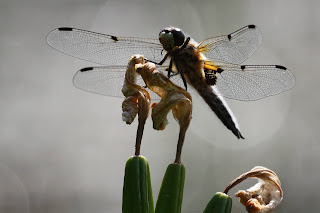So mild, so quiet breathes the balmy air,
Scenting the
perfume of decaying leaves
Such fragrance and such loveliness they wear-
Trees, hedgerows, bushes – that the heart receives
Joys for which language owneth words too few
To paint that glowing richness which I view.
From Colours of Autumn. John Clare
As we basked in the sun, some very good sightings were made including four grebe species, Slavonian, Red necked, Great Crested and Little Grebe. A Marsh Harrier made a fly past, flying parallel to the pond, a Kestrel hovered directly in front of us, a Common Buzzard flew by, a Sparrowhawk flew in the far distance and a Peregrine Falcon flew swiftly past and away from us. So not a bad way to begin the day, four grebes and five raptors from that one spot. Unfortunately, were unable to pick up the Great Northern Diver which must have been hidden by the side of the pond. Even after we returned later in the day we had no luck in finding this one.
Grey
Herons were posted
equally spaced and sentinel like along the bank at the back of the pond, a Common
Snipe lifted at the edge of the pond, a skein of calling Pink-footed
Geese flew northwards and a small party of Whooper Swans were also
in the air. Waterfowl on the water
included Canada Geese, Wigeon, Teal, Goldeneye and Tufted Duck. A Roe Deer moved through the field
behind the lake, half hidden by growth of similar pastel colouring to itself. Calls from or over the trees behind us
included that of Siskin, Coal Tit and Goldcrest. A Water Rail called from the pond area.
A confiding Robin watched us walk
by.
And it would be the same were no house near,
Over all sorts of weather, men, and times
Aspens must shake their leaves and men may hear
But need not listen, more than to my rhymes.
Whatever wind blows, while they and I have leaves
We cannot other than an Aspen be
That ceaselessly, unreasonably grieves,
Or so men think that like a different tree.
From Aspens by Edward Thomas (July 1915), Edward Thomas died
in the Great War at Arras in 1917)
We found little birdlife by the mouth of the burn which meandered attractively seawards. Gulls and a few Sanderlings were at the tideline, Meadow Pipit and Pied Wagtail were present and a flock of Goldfinch flew by. A few walkers were seen but overall, it was a peaceful experience here. One of the good experiences in life is watching and listening the tide as it meets the shoreline. The sea was as calm as it ever is in these parts. We walked back past the Sea Buckthorn and found a pair of Stonechat before reaching the car.
As we made
off towards the car we watched another Marsh Harrier.
Now in
fading light we decided to give the hide a miss. Content with our few hours birding in
wonderful autumnal conditions we made for home.
Qeesti giorni guando vien il belle sole Questi giorni guando
vieni belle sole
On Days like these when skies are blue and fields are green
I look around and think of what might have been.
Matt Monro et al

















































